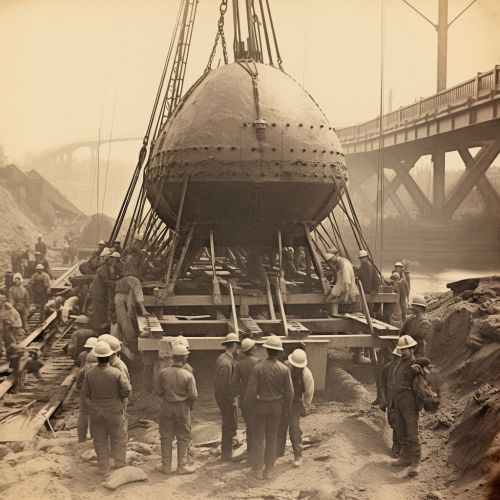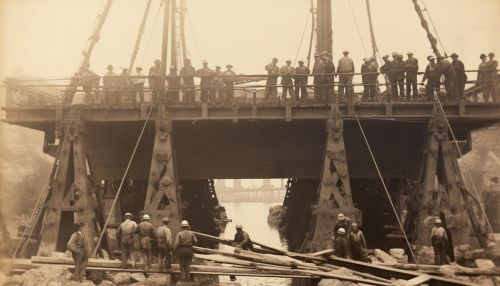Caisson (engineering)
Definition and Purpose
A caisson in engineering is a watertight retaining structure used primarily in the construction of bridges and other structures such as dams. It is used to work on the foundations of a bridge pier, for the construction of a concrete dam, or for the repair of ships. Caissons are constructed in such a way that the water can be pumped out, keeping the work environment dry. When piers are being built using an open caisson, and it is not practical to reach suitable soil, friction pilings may be driven to form a suitable sub-foundation. These piles are connected by a foundation pad upon which the column pier is erected.
History
The use of caissons in construction dates back to antiquity, with the earliest known use being in the construction of harbor facilities in the ancient city of Carthage. The Romans also used caissons in their construction projects, most notably in the building of their extensive system of aqueducts. The technology was further developed in the 19th century with the advent of industrialization.
Types of Caissons
There are several types of caissons used in construction, each with its own specific uses and advantages. These include the open caisson, the pneumatic caisson, the floating caisson, and the box caisson.
Open Caisson
An open caisson is open at the bottom and is sunk through the soft mud or loose sand until it rests on solid ground. The open caisson is suitable for use in soft clays, sands, and gravels and is not suitable for places where there may be large boulders or bedrock.
Pneumatic Caisson
A pneumatic caisson is a type of caisson that is used where the soil under the water is too loose or soft. It is essentially a large box with no bottom, and with the top sealed against water and air penetration. The air pressure within the caisson is maintained in order to prevent water and mud from seeping in from below.
Floating Caisson
A floating caisson, also known as a floating dock, is used for the construction of bridges across rivers with high currents. It is a box caisson that is constructed of heavy timber and steel, and is floated to the desired location and then sunk into place.
Box Caisson
A box caisson is a prefabricated concrete box; it is put into place and then filled with concrete. This type of caisson is used where the soil is weak, and therefore requires a large bearing area to distribute the load of the structure.
Construction Process
The construction process of a caisson involves several steps, including the preparation of the site, the construction of the caisson, and the sinking of the caisson to the desired depth. The process requires careful planning and coordination, as well as the use of specialized equipment.
Applications
Caissons are used in a variety of construction projects, including bridges, dams, and skyscrapers. They are also used in the construction of offshore oil platforms, where they serve as the foundation for the platform structure.
Advantages and Disadvantages
Like any construction technique, the use of caissons comes with its own set of advantages and disadvantages. The main advantage of using caissons is that they allow construction to proceed in areas where it would otherwise be difficult due to the presence of water or unsuitable soil. However, the construction of caissons can be a complex and time-consuming process, and it also carries the risk of worker injury due to the high pressures involved in the construction process.
See Also


